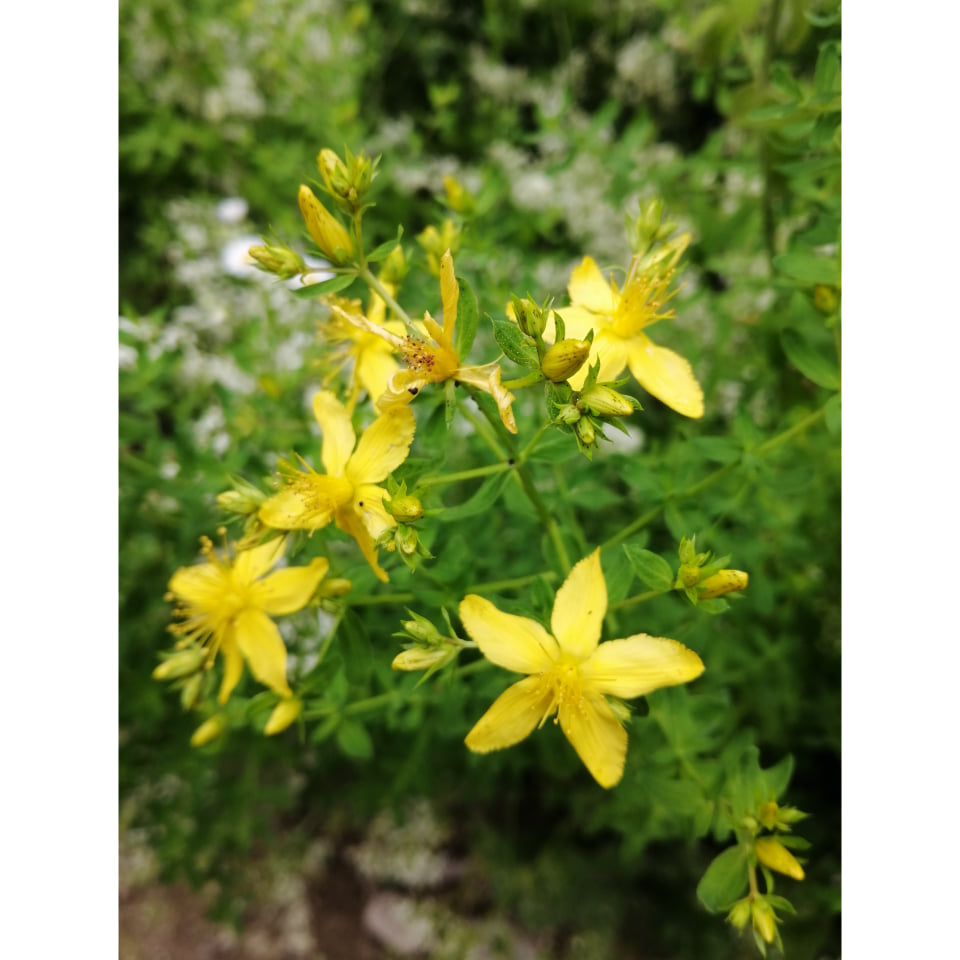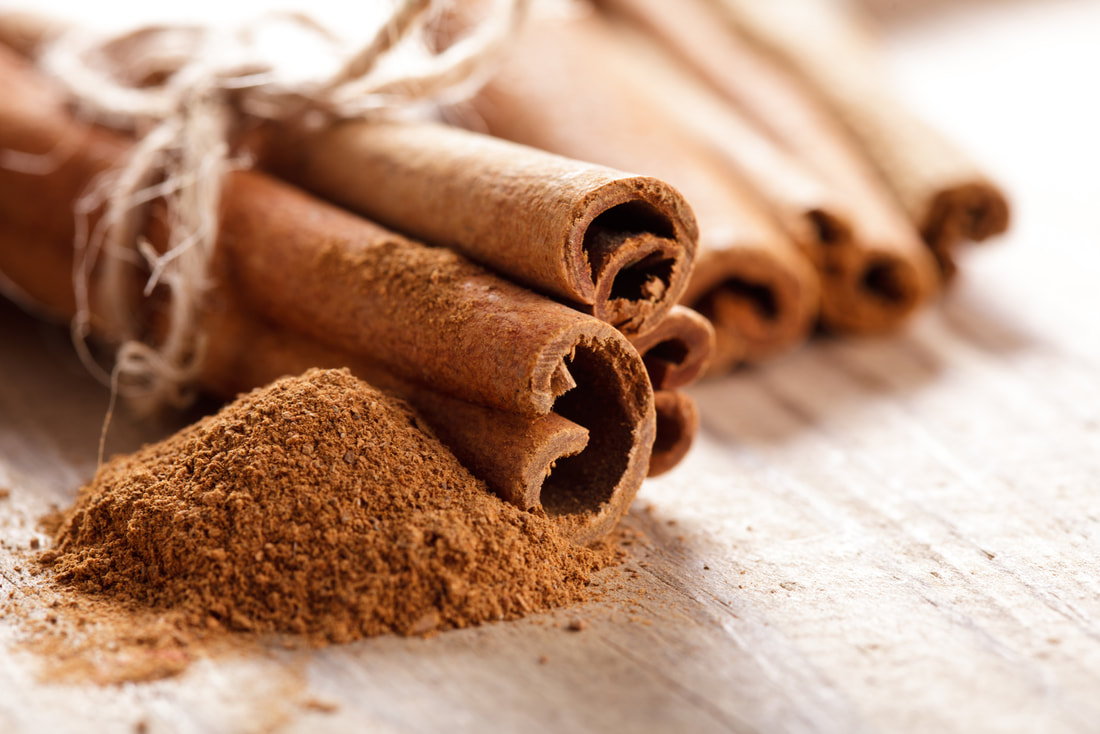|
St. John's wort (Hypericum perforatum) is in full bloom in New Brunswick right now. It is a beautiful plant, with cheerful yellow flowers. It has quite a distinct smell, and some very unique characteristics. It can grow several feet tall, and has a woody base. The flowers grow in clusters at the end of the branches. Each flower is bright yellow, has five petals, numerous stamen, and a single pistil. The leaves and flowers have small black dots. The leaves, if held up to the light, are peppered with transparent 'holes' (actually oil glands), which makes sense when you consider the latin name of the plant, perforatum (perforation). Possibly the coolest part of the plant, though, is that despite it's cheerful yellow colour, it 'bleeds' a dark purple. Squeeze a plump flower bud between your fingers, and it will stain your fingertips dark purple. St. John's wort has been extensively studied for its actions against mild and moderate depression. It has gained such a solid reputation as an antidepressant that it isn't strange anymore to have allopathic doctors recommend it to their patients who wish to avoid pharmaceutical antidepressants. It is not, however, a pharmaceutical and lacks the instant action that some people have come to expect from man-made drugs. It needs to be taken over a period of time for its full effect to be felt, at least 2-3 weeks, and often months. Used properly, it is very effective due to the herb's active constituents. These increase the serotonin levels in the body, and level out the 'feel-good' neurotransmitters of dopamine, serotonin, and noradenaline to make them last longer in the body. Topically, St. John's wort is wonderful for soothing and healing bruises, sore muscles, sprains, and burns. It is best used as an oil in this case. The oil and tincture must be made with fresh buds and flowers for it to be effective because the hypericin (active constituent) does not last as well in the dried plant matter. So, the few weeks when St. John's wort is ready is a very busy time of oil and tincture making! To know when the plant is ready, squeeze a bud between your fingers. If it is filled with purple 'juice', it's time. These flowers and buds are at their peak. Most of the plant is at the bud stage, which is best. The buds are plump and juicy and ready to be made into remedies! St John's Wort Tincture St. John's wort flowers and buds vodka glass jar with lid label Method: 1. On a bright, warm day, pick enough St. John's wort buds and flowers to fill a glass jar 3/4 full. The plant matter should be fairly packed, but not too tightly. 2. Fill the jar with vodka (80 proof, or 40% alcohol) so there is very little headspace. The alcohol must completely cover the plant matter. Use a spoon to smoosh down the herbs if they float. 3. Cap the jar, being sure to put a non metal barrier between the alcohol and the lid. Parchment paper or plastic wrap works well. 4. Label with the ingredients and date. Store in a dark, cool cupboard for 6 weeks, shaking daily. The tincture will be a deep red colour. DOSE: Generally, 1/2 to 1 tsp twice daily. Cycling is important. Take it for 3 weeks, discontinue for 1 week, and repeat. SAFETY: Some people experience photosensitivity when taking St. John's wort. Discontinue if you experience skin issues. St. John's wort should not be taken in conjunction with pharmaceutical antidepressants without the guidance of your doctor. If pregnant or breastfeeding, seek the guidance of a health-care practitioner. ** This is fun, right?! And that's all it is for now. Information on the traditional uses and properties of herbs in this website are for educational use only, and are not to be mistaken for medical advice. Every attempt has been made for accuracy, but none is guaranteed. Many traditional uses and properties of herbs have not been validated by the FDA or Health Canada. If you have health issues, concerns, or questions, consult your health care practitioner. ** More info: Gladstar, Rosemary, Medicinal Herbs A Beginner's Guide, Story Publishing, North Adams, MA. 2012 https://www.ediblewildfood.com/st-johns-wort.aspx
0 Comments
When I think winter herbs, cinnamon immediately comes to mind. An herb that warms the system, I associate it with comfort foods...cinnamon buns, cookies, spice cake, sprinkled in hot chocolate, and oatmeal. Sweet and spicy all at once, it's a delightful addition to savory cooking. Curries and stir fries are amazing with a pinch of cinnamon!
How wonderful, then, that such a delicious herb has a wide array of therapeutic benefits, too! Cinnamon is considered a warming herb, and can be a great help to those who 'run cold' or are dealing with 'cold' afflictions. It is one of the 'anti' herbs. It is antimicrobial, antioxidant, antiseptic, antiviral as well as astringent, carminative, and demulcent. These actions make it perfect for use during cold season. Cinnamon is often included in cough syrups, cold and flu teas, and elderberry syrup. For those living with diabetes type 2, cinnamon can be a useful tool. The herb does this in two ways - by increasing the body's sensitivity to insulin, and by decreasing the amount of sugar released into the bloodstream. Cinnamon does this by interfering with certain digestive enzymes, slowing down the breakdown of carbohydrates in the digestive system. Cinnamon is also celebrated for its beneficial action on the cardiovascular system, its antioxidant content, anti-inflammatory properties, its positive effects against fungal growth, and its protective action against oral disease and cavities. There are two basic types of cinnamon to consider. The main difference between the two is the level of cinnamaldehyde in the herb. Cinnamaldehyde is what gives cinnamon its distinctive taste. Though you may think that more is better, there is such a thing as too much of a good thing. When using cinnamon therapeutically for chronic ailments, it is best to adopt an 'easy does it' attitude. Ceylon cinnamon is known as 'true' cinnamon. It comes from the inner bark of the Cinnamomum verum tree which grow in Sri Lanka and India. It is lower in cinnamaldehyde, and thus is a safer option for long term therapeutic use. Cassia cinnamon is from the Cinnamomum cassia tree which originates in China. It is higher in cinnamaldehyde. It is also higher in coumarin, which in large amounts can be damaging to the liver. It is the stronger tasting of the two cinnamons, and the cheapest. Thus it is the cinnamon most readily available at the grocery store, and is likely used in baking for this reason. In food amounts, cinnamon is quite safe. It should not be used therapeutically by pregnant ladies, however, as it can cause contractions. It is best to consult an herbalist for dosing specifics. Perhaps the best thing about cinnamon - or at least, the tastiest - is its effect on the digestive system. Cinnamon is a traditional digestive remedy, and combines especially well with ginger. Warming herbs kindle the body, building 'fire' and getting things moving. This is good news for those with a sluggish digestive system who need to encourage things along. It is normal for many cultures to partake in a digestive drink before and/or after meals, and cinnamon is often included in these teas. Try one for yourself with the recipe below: Cinnamon Digestive Tea 1 part cinnamon 1 part ginger 1/2 part clove 1 part mint Blend the first three ingredients together. Place 2 tablespoons of this blend into a pot with 2 cups of water. Simmer 10 minutes. Add 1 tablespoon mint, cover, and let steep for 5-10 minutes. Strain, sweeten with honey as desired, and sip slowly. |
Emilie
Clinical herbalist. Mother. Teacher. Ever student. Archives
February 2022
Categories
All
|




 RSS Feed
RSS Feed